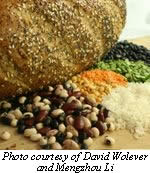

36 Lombard Street, Suite 100,
Toronto, Ontario Canada M5C 2X3
Tel 416-861-0506 Fax 416-861-0649
www.gilabs.com
 The
Blood Sugar Rollercoaster – Wheee!
The
Blood Sugar Rollercoaster – Wheee!
For some of us, the thrill of riding an amusement park roller coaster is an unmatched pleasure! The rapid climb to dizzying heights, the brief stomach-lurching feeling of zero gravity at the peak, and the out-of-control, white-knuckled hurtling down to earth leaves us weak-kneed - and possibly asking for more.
However, in our daily meal choices, a rollercoaster ride is definitely not something we should aim for.
Is this something you recognize?: You’re hungry and sleepy, so you eat something – maybe a donut or cookie - that gives you a quick blood sugar jolt. An hour or so later, though, your “pep” has petered out, and you’re hungry again. So you repeat - climb and crash.
Glycemic Index – Measuring the Climb and Crash
The Glycemic Index (GI) is a system which ranks the quality of the carbohydrate in a food according to the effect the carbohydrate has on blood glucose levels. Foods containing carbohydrates which are easily and quickly digested, causing a rapid spike and subsequent crash in your blood sugar, are “high GI” foods. In contrast, carbohydrates which are digested more slowly, resulting in a more gradual, sustained release of energy, are “lower GI” foods.
The GI of carbohydrate-containing foods is measured in a carefully controlled, clinical laboratory setting. Volunteer subjects eat a fixed sample of the foods, and the effect these foods have on their blood sugar levels (over two hours) is then measured and compared to pure glucose, which has its Glycemic Index set at 100.
Remarkably, although each of our blood sugar levels may climb to a different absolute level, the individually-calibrated relative ratio of responses to different foods is consistent between people!
GI – The Science Behind It
The Glycemic Index was conceived in 1979 by Dr. David Jenkins, together with Dr. Thomas Wolever, Dr. Alexandra Jenkins, and others. The GI breakthrough was the outcome of research conducted at both Oxford University and at the University of Toronto to determine which foods would be best suited for people with diabetes.
“Research has shown, however, that lowering the GI of your diet can
have wide-reaching, long-term health benefits for everyone,” says Dr.
Alexandra Jenkins, Director of Research at Glycemic Index Laboratories. Benefits
include:
•
Reduced risk of developing diabetes or heart disease
•
Improved appetite control, and help with weight loss & control
•
Reduced cardio-vascular disease risk factors
GI – How to Use It
 When choosing carbohydrate-containing foods, select lower GI foods more often.
Some examples of low GI foods are: whole grain bread, converted parboiled rice,
lentils, beans, apples, and ‘al dente’ pasta.
When choosing carbohydrate-containing foods, select lower GI foods more often.
Some examples of low GI foods are: whole grain bread, converted parboiled rice,
lentils, beans, apples, and ‘al dente’ pasta.
On the other hand, here are examples of higher GI foods which should be eaten less often: regular white or whole wheat bread, instant mashed potatoes, graham wafers, and waffles. These foods are more easily digested, and therefore are converted to blood sugar more rapidly.
When selecting lower GI foods, remember:
•
Use common sense – as always, also pay attention to portion size, calories,
fat & saturated fat content, and other important nutritional factors
• Look for foods that have been properly tested - lower GI foods are considered to be GI = 55 or lower (whereas high foods are GI = 70 or higher). If you are unable to find your favorite food’s GI value on its label, check with published directories of GI values – available on-line at www.glycemicindex.com
For more information, tips, delicious low-GI recipes, and GI news, see www.gilabs.com or ginews.blogspot.com
Written by Katherine Corbett,
Director of Business Development,
Glycemic Index Laboratories, Inc.